|
When the winter months blanket us with a mixture of
deep snow and ice, the first severe drop in temperatures down around the
zero range find some of our llamas suddenly shivering. When temperatures
descend gradually, as they normally do in the fall months, they all seem
to be adapted and ready for it, but when the temps drop suddenly,
sometimes combined with drenching rain, it can be quite a shock to some of
them. Normally some kind of shelter will provide them enough for comfort.
However, some short-wooled llamas and some older, thin animals do need a little more attention in the cold weather. Without the surplus fat on their body, you can almost see the calories blowing off some of these older llamas. They would benefit from a horse blanket or possibly a "designer llama blanket" made from a sleeping bag. (purchased in the sports department for only $14 at Wal-Mart). Additional feed and cracked corn will help their body heat and a sheltered place to bed down in a deep layer of straw will help to keep them comfortable.
(see below for information on llama coats).
Some kind of heated area is almost necessary for a new cria born in these temperatures or for an animal that is ill. A safe, heated "emergency room" in the barn is the ideal, but most barns don't offer that luxury. Infared Heat Lamps can help warm an area but they should be used only with extreme caution. They can be wired or nailed securely in place so they cannot get knocked down, but there still is the danger of burning an animal if it gets too close and also the danger of a barn fire with all the hay around. Any type of heater that uses a fuel is also considered dangerous when used unsupervised around the animals. The DeLonghi radiator heater has been recommended to be the safest heater available. Available at stores like K-Mart, Wal-Mart, and Menard's for about $50.00, it is thermostat controlled and kid safe - never too hot to touch. Although this heater will not heat a barn, it will do a good job of raising the temperature to a comfortable llama level in an enclosed stall sized area. We've found it to be very effective in a tent-like structure with vinyl sides and a ceiling of ten feet.
A warm, cozy spot can be created for your crias in your creep feeder or even in a corner of the barn by making walls of hay or straw bales. Protected from drafts and thickly bedded with straw, the crias can cozy up together and enjoy their own supply of grain, cracked corn, and a higher protein hay. Additional warmth can be provided with cria coats and dog sweaters. Cria neck warmers can be made from sleeves of old sweaters or sweatshirts.
Freezing water buckets are a problem in this weather - except for those who have heated, automatic waterers! Definitely a good investment! The next best thing would be the insulated,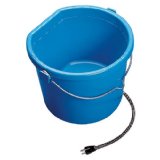 heated buckets. Flat on one side, they hang nicely and keep the water from freezing. The electric cord exits from the bottom of the pail and is wrapped with wire to prevent chewing. These usually run about $40.00 from any farm supplier. Floating tank heaters can also be used but some have reservations about the complete safety of this type of heater. Animals have been known to pull them out of the water buckets and the heater can then possibly start a fire in the hay. For complete safety, these heaters should not be used without a GFI outlet. heated buckets. Flat on one side, they hang nicely and keep the water from freezing. The electric cord exits from the bottom of the pail and is wrapped with wire to prevent chewing. These usually run about $40.00 from any farm supplier. Floating tank heaters can also be used but some have reservations about the complete safety of this type of heater. Animals have been known to pull them out of the water buckets and the heater can then possibly start a fire in the hay. For complete safety, these heaters should not be used without a GFI outlet.
Just carrying hay and water in deep snow proves to be quite challenging. Short of a motorized vehicle that will soar over the snow, an old toboggan or sled
can to simplify this job.
This article, written by Marilyn Nenni, appeared in the Hoosier Hummer
Magazine.
~~~~~~~~~~~~~~~~~~~~~~~~~~~~~~~~~~~~~~~~~~~~~~~~~~~~~~~~~~~~~~~~~
a good read
Cold Weather Management
Tips for Camelids
By Stephen Hull, MS, PhD, and Tom Cameron, DVM
~~~~~~~~~~~~~~~~~~~~~~~~~~~~~~~~~~~~~~~~~~~~~~~~~~~~~~~~~~~~~~~~~
Critical hypothermia occurs when core body temperature drops below
90 F.
TREATMENT OF
HYPOTHERMIA
&
WINTERIZING YOUR
CAMELID CARE PROGRAM
By Dr. David Anderson, DVM, MS, Diplomate ACVS ~~~~~~~~~~~~~~~~~~~~~~~~~~~~~~~~~~~~~~~~~~~~~~~~~~~~~~~~~~~~~~~~~
Cold Weather Tips
from the New Jersey Dept. of Agriculture
~~~~~~~~~~~~~~~~~~~~~~~~~~~~~~~~~~~~~~~~~~~~~~~~~~~~~~~~~~~~~~~~~
Warm Coat Tips for Older or Short-Wooled Llamas
From one owner: "I know that you may all laugh at what I did for my
elderly alpaca, Stanley. I went to Goodwill and bought a good quality woman's
winter coat with an outer water-repellent shell. I turned the sleeves inside
out and sewed them to the lining of the coat, and removed the zipper. I fed a
soft cloth belt through a tubular collar so it could tie in front of his neck,
and used a strip of a wool blanket for a cinch band tied in a bow on his back.
He looked like a little Christmas package, but he was warm all winter! (Talk
about cheap!) :-)
|
Warm, waterproof Llama Coats and Neckwarmers
are available from
Llama Hardware. |
|
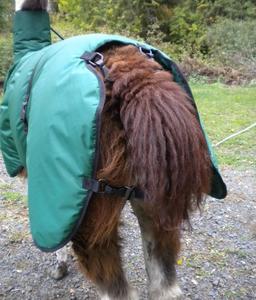 |
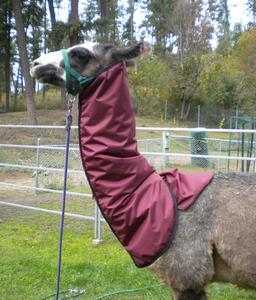
|
|
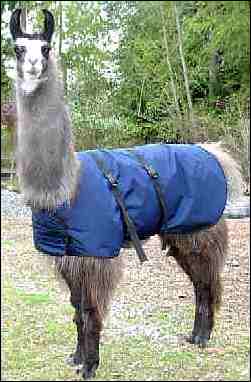 |
Waterproof Llama Coats made by Kate Otey
Well fitting and warm.
Kate's Kreations |
|
Sleeping Bag Coat
|
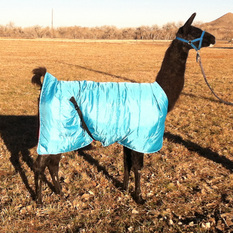
|
|
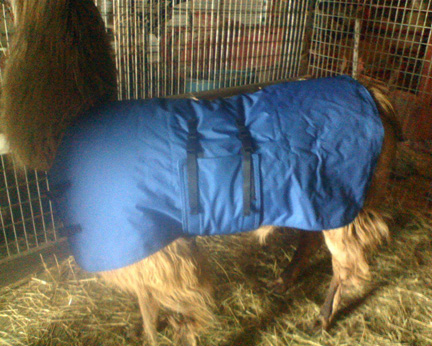
|
Llama Coats made by
Carol Whipple
Freedom Acres
Llamas
Outer coat is nylon cordura cloth which is
light weight, strong, and highly water repellent. Inner coat is soft, warm
anti-pill fleece which feels natural to the llama. Coat is double stitched with
strong, heavy duty nylon thread. Belly flap has super strong velcro and is
further anchored in place with sturdy nylon strapping and buckles. Belly flaps
are extra wide which provide comfort and are easy to close. The soft part of
the velcro is on the flap so it won't catch in llama's fiber. The flap is
adjustable to each animal's size. This coat is made to last for years to come!
Six sizes, prices vary from $35 to $80. See measurements and prices
here. |
|